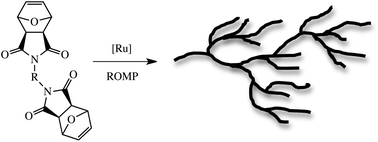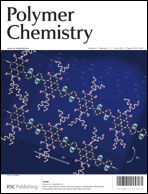Nucleophilic thiol-Michael chemistry and hyperbranched (co)polymers: synthesis and ring-opening metathesis (co)polymerization of novel difunctional exo-7-oxanorbornenes with in situ inimer formation†
Abstract
Nucleophile-initiated thiol-Michael chemistry was employed to prepare a series of mono- and di-functional exo-7-oxanorbornenes from the reaction between mono- or dithiols with 2-((3aR,7aS)-1,3-dioxo-3a,4,7,7a-tetrahydro-1H-4,7-epoxyisoindol-2(3H)-yl)ethyl acrylate. Homopolymerization of the difunctional species, bis(2-((3aR,7aS)-1,3-dioxo-3a,4,7,7a-tetrahydro-1H-4,7-epoxyisoindol-2(3H)-yl)ethyl)-3,3′-((1,4-phenylenebis(methylene))bis (sulfanediyl))dipropanoate (M1), with Grubbs' first generation catalyst, RuCl2(PCy3)2CHPh, yields a hyperbranched polymer with up to 90% of polymerizable C![[double bond, length as m-dash]](https://www.rsc.org/images/entities/char_e001.gif) C bonds consumed as judged by 1H NMR spectroscopy. SEC analysis is consistent with the formation of a hyperbranched structure with an absolute weight average molecular weight (Mw), as measured by static light scattering in CH2Cl2, determined to be 381 000. Bis(2-((3aR,7aS)-1,3-dioxo-3a,4,7,7a-tetrahydro-1H-4,7-epoxyisoindol-2(3H)-yl)ethyl)-3,3′-((thiobis(ethane-2,1-diyl))bis (sulfanediyl))dipropanoate (M2) could not be polymerized with the Grubbs' 1st generation catalyst but rapidly polymerized with 50% conversion of monomeric C
C bonds consumed as judged by 1H NMR spectroscopy. SEC analysis is consistent with the formation of a hyperbranched structure with an absolute weight average molecular weight (Mw), as measured by static light scattering in CH2Cl2, determined to be 381 000. Bis(2-((3aR,7aS)-1,3-dioxo-3a,4,7,7a-tetrahydro-1H-4,7-epoxyisoindol-2(3H)-yl)ethyl)-3,3′-((thiobis(ethane-2,1-diyl))bis (sulfanediyl))dipropanoate (M2) could not be polymerized with the Grubbs' 1st generation catalyst but rapidly polymerized with 50% conversion of monomeric C![[double bond, length as m-dash]](https://www.rsc.org/images/entities/char_e001.gif) C bonds with the Grubbs' 3rd generation species. Bis(2-((3aR,7aS)-1,3-dioxo-3a,4,7,7a-tetrahydro-1H-4,7-epoxyisoindol-2(3H)-yl)ethyl)-7,10-dioxa-4,13-dithiahexadecane-1,16-dioate (M3), in a similar fashion to M1, could be readily homopolymerized to high conversion with the 1st generation species giving organosoluble material. The statistical copolymerization of M1 or M3 with a series of monofunctional monomers containing pyrrole, fluoro, POSS and fluorene functionality is demonstrated. Copolymers of variable composition are readily prepared with the Grubbs' 1st generation catalyst with, in general, C
C bonds with the Grubbs' 3rd generation species. Bis(2-((3aR,7aS)-1,3-dioxo-3a,4,7,7a-tetrahydro-1H-4,7-epoxyisoindol-2(3H)-yl)ethyl)-7,10-dioxa-4,13-dithiahexadecane-1,16-dioate (M3), in a similar fashion to M1, could be readily homopolymerized to high conversion with the 1st generation species giving organosoluble material. The statistical copolymerization of M1 or M3 with a series of monofunctional monomers containing pyrrole, fluoro, POSS and fluorene functionality is demonstrated. Copolymers of variable composition are readily prepared with the Grubbs' 1st generation catalyst with, in general, C![[double bond, length as m-dash]](https://www.rsc.org/images/entities/char_e001.gif) C bond conversions in excess of 90%. Finally, the preparation of novel linear-hyperbranched AB diblock copolymers is demonstrated via the sequential polymerization of a monofunctional sugar derivative, (2S,3S,4S,5R,6R)-6-((3-(2-((3aR,7aS)-1,3-dioxo-3a,4,7,7a-tetrahydro-1H-4,7-epoxyisoindol-2(3H)-yl)ethoxy)-3-oxopropyl)thio) tetrahydro-2H-pyran-2,3,4,5-tetrayl tetraacetate (M8) which yields a well-defined linear homopolymer, as judged by SEC, followed by chain extension with the difunctional substrate M3.
C bond conversions in excess of 90%. Finally, the preparation of novel linear-hyperbranched AB diblock copolymers is demonstrated via the sequential polymerization of a monofunctional sugar derivative, (2S,3S,4S,5R,6R)-6-((3-(2-((3aR,7aS)-1,3-dioxo-3a,4,7,7a-tetrahydro-1H-4,7-epoxyisoindol-2(3H)-yl)ethoxy)-3-oxopropyl)thio) tetrahydro-2H-pyran-2,3,4,5-tetrayl tetraacetate (M8) which yields a well-defined linear homopolymer, as judged by SEC, followed by chain extension with the difunctional substrate M3.


 Please wait while we load your content...
Please wait while we load your content...